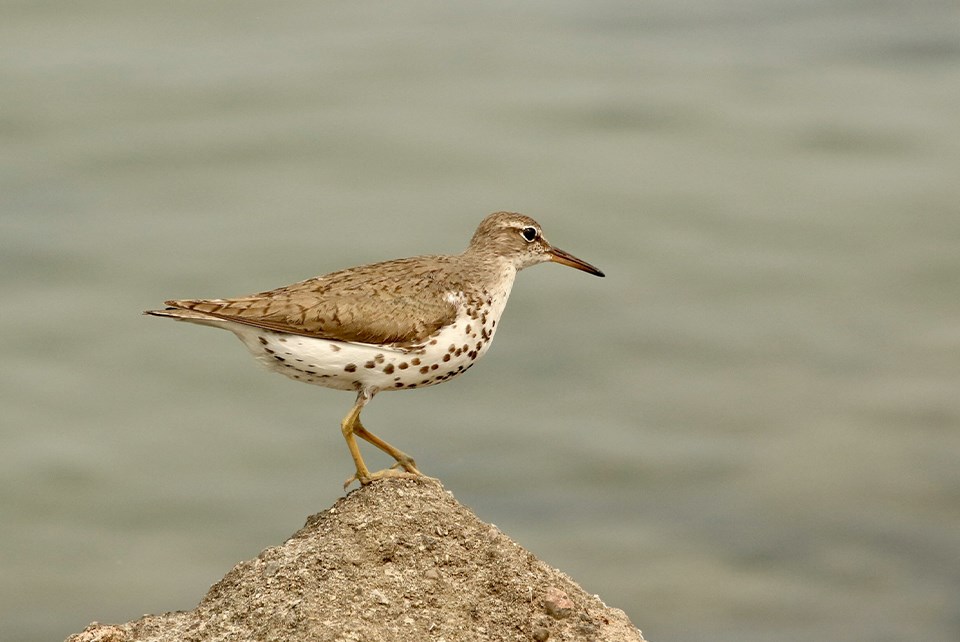SASKATCHEWAN — White-throated sparrows teach each other new songs on migration stop-overs. Dainty Tennessee warblers make unexpectedly long stops in Quebec’s semi-urban forests to replace their flight feathers. Sandpipers use temporary wetlands created by flooding farm fields in the Mississippi Valley.
These are some of the discoveries researchers have made from strapping tiny solar-powered backpacks to migratory songbirds.
For the past 10 years, scientists, educators and organizations across North America and beyond have been contributing to a program that follows the paths of migratory birds on their epic journeys by outfitting them with solar-powered “backpack” trackers no bigger than a dime. It’s an ambitious international network called , which is Latin for movement or motion.
“Essentially Motus uses radio telemetry to track small flying animals,” Amie MacDonald, a migration scientist with Birds Canada who works on the network in British Columbia, tells The Narwhal. “Mostly that’s birds, but it’s also been used to track bats in several studies and there’s even been some work on large insects like monarch butterflies or darner dragonflies.”
Birds Canada, a national conservation group, launched the project about a decade ago, partnering with individuals and organizations around the world. Today, 34 countries contribute to the Motus database and researchers have produced more than 200 publications based on the data. MacDonald says the collaborative nature of the project means it’s easier for researchers to leverage limited conservation funding, which often comes with restrictions based on geographical location.
Migrating species don’t care about political borders — and neither does climate change. Every year, tens of millions of birds take to the skies along major migratory routes like the , an aerial artery that stretches from Alaska to Patagonia.
Climate change is causing cascading and, in some cases, catastrophic effects on birds’ seasonal stopover locations, breeding grounds and wintering sites, which are also under threat from habitat loss. Drought in California, for instance, reduces available habitat for birds that call both Colombia and British Columbia home for part of the year.
And at home, MacDonald notes there is increasing interest in using the Motus network to study the impact of renewable energy projects. In December, for example, British Columiba announced it had , exempting them from the environmental assessment process.
“We’re starting to look at potential opportunities to co-locate Motus stations with offshore wind energy, seeing how Motus can help to understand potential impacts, in terms of placement,” she says.
From backpacks to towers: how Motus works
The Motus network allows researchers to share information about individual birds as they cross borders using radio tags that operate on the same frequency; each one has a digital identifier.
“That’s what enables the scale of the system because all of the receivers can be listening for these shared frequencies,” she says. “So animals that get tagged, say, in northern British Columbia, can be detected not only by stations set up by those same projects that I’m working on but also by other stations in Costa Rica that are set up by other folks who are not directly collaborating with me necessarily, but are part of the same Motus network.”
If a bird with a solar-powered backpack flies past a Motus receiver, the data will be recorded and shared to the entire network, including with participants thousands of kilometres away. Scientists and conservationists can start to piece together the details of where birds are going, what their specific needs are and where they might be running into trouble.
“Understanding where birds are going across their full annual cycle can give us more insight into threats they might be facing,” she says.
White-throated sparrows show ‘cultural transmission of song’
Beyond practical applications, the network is providing fascinating insights into bird behaviour. MacDonald says they tracked the migration routes of white-throated sparrows from northern B.C. to develop a “potential hypothesis” on how the birds are sharing songs.
“It’s not necessarily related to climate or directly related to conservation, but it’s an interesting way that being able to track small birds at long distances can give us some insight into why these things might be happening,” she says.
Different breeding populations — sometimes separated by hundreds of kilometres — somehow learned the same songs, which was initially a head-scratcher for scientists observing the populations.
“They started singing different variations of their song and then it spread quite quickly,” she says. “But they’re overlapping on migration. On the non-breeding grounds, they may be learning these different song variants and then bringing them back to their breeding territories — which is just kind of neat. You can call it kind of a cultural transmission of song.”
Tracking birds can help answer questions about how drought affects migration
MacDonald started studying birds as a way to spend more time outdoors. One of her current projects is in the Fraser River estuary, collaborating with researchers in California and Mexico, to understand how shorebird physiology and movement are affected by drought in California’s Central Valley.
“We can work together to track birds in those different locations and hopefully compare how the physiology of the birds differs among the different sites where they spend the non-breeding season and then link that to any potential differences in movement patterns.”
Researchers can use Motus to answer questions about how drought and other factors affect migration — and whether the birds that make it are breeding in sufficient numbers to sustain the population.
Some of their research feeds into unique conservation projects in California and other states, where rice farmers are paid to flood their fields at specific times of year, creating temporary wetlands that benefit migrating shorebirds and other species. MacDonald is hopeful the work will feed into existing programs to support the birds.
“In B.C., we are tagging birds at another site along the coast that hasn’t been experiencing that level of drought to compare.”




